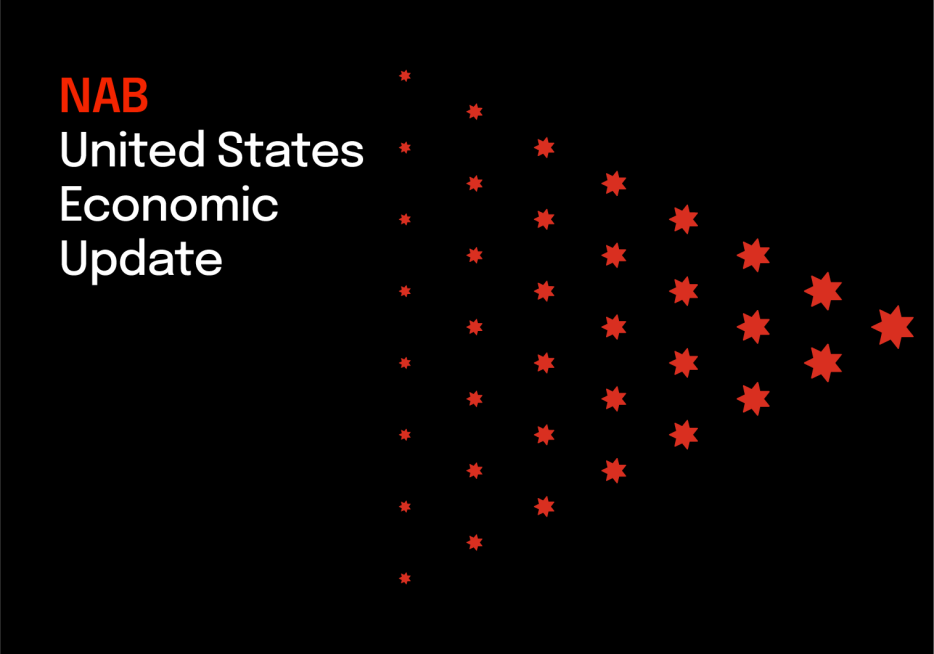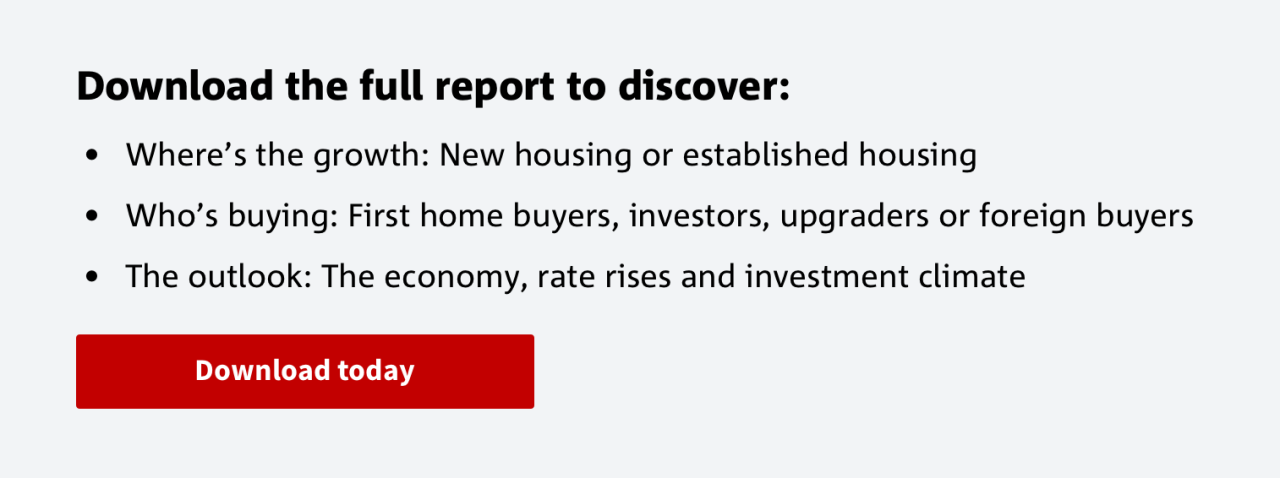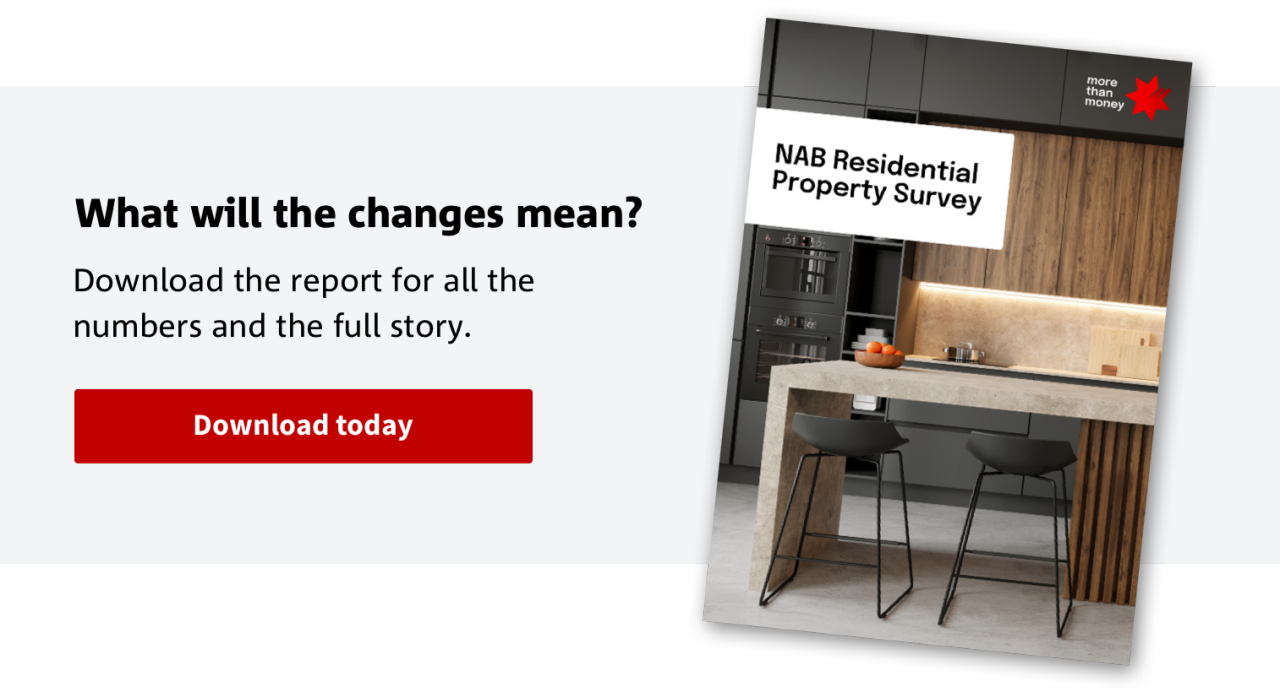28 August 2025
May 9, 2025
NAB Quarterly Australian Residential Property Survey Q1 2025
Housing market sentiment rallied as national housing price growth accelerated in the March quarter.
February’s rate cut is also likely to have supported the lift in the NAB Residential Property Index to a well above average +40 after moving lower in the previous 3 quarters. Sentiment is now positive across the country, except the ACT. With rates now lower and expected to fall further, confidence also improved. Most property professionals in WA, QLD and SA assess market conditions as rising, approaching their peak or at the peak of the market, while VIC and NSW are at the start of recovery. Foreign buyers were more active in March quarter but may have been prompted by temporary bans from purchasing established dwellings from April 1.
NAB’s outlook for property prices is broadly unchanged. We see the 8-capital city dwelling price index ending the year around 3% higher, with a larger increase of around 6% over 2026.
Survey highlights
Housing market sentiment rallied in the March quarter as national house price growth accelerated. February’s rate cut is likely to have also factored. Overall, the NAB Residential Property Index rose to a well above average +40, after moving lower in the previous three quarters.
Sentiment lifted across the country, except in TAS (though still positive at +33). Sentiment was highest in the NT (+100) and SA (+80) and bounced back into positive territory (though still below average) in NSW (+31) and VIC (+16) where home values has also started growing again in recent months. Sentiment in the ACT however remained negative (-25).
When property professionals were asked to best describe the state of the housing market in areas where they operate compared to the previous quarter, the majority in WA (84%), QLD (74%) and SA (70%) said the market is rising, approaching the peak or at the peak. In VIC (44%) and NSW (40%) however, most believe housing markets are now at the start of recovery.
With interest rates widely tipped to continue falling (NAB now sees the RBA easing more quickly to reach a neutral stance of 3.10% by Q3), confidence levels also bounced with both short (+51) and long term (+54 pts) measures up sharply after falling below average in the last quarter. Short-term confidence is highest in the NT (+100) and SA (+65) and lowest in VIC (+41) and NSW (+49). The 2-year measure is highest in the NT (+100) and TAS (+67) and lowest in the ACT (0) and WA (+30).
The average survey expectation for house price growth was raised to 2.3% for the next 12 months (from 1.2%) and 3.1% in 2 years’ time (from 2.7%). But expectations vary across the country. They are now positive and higher in all states bar QLD and TAS. Expectations are most positive in the NT (5.0%) and WA (4.7%) and lowest in VIC (0.8%). Longer term projections also increased in all states bar WA where they were trimmed back (2.9%) and unchanged in NSW (2.7%). The outlook is strongest for TAS (4.8%) and the NT (4.4%) and lowest in the ACT (2.2%) and NSW (2.7%).
CoreLogic data shows rental values reached a record high in March 2025. In annual terms however, it slowed from a cyclical peak of 9.7% in the year to November 2021 to 3.1% in the year to March 2025 – the slowest rate of growth since March 2021. Despite this, surveyed property professionals expect rental growth to accelerate, with expectations for the next year raised to 2.2% (1.6% previously) and 2.7% in 2 years’ time (2.6% previously). Expectations are higher in all states for the next year except in the NT and VIC. Positive income returns are also forecast across Australia in 2 years’ time except in the ACT. That said, expectations were also scaled back in VIC, SA, WA and the ACT.
The market share of FHBs in new housing markets in the March quarter fell to 34.2% after climbing to a 2-year high 38.2% in the final quarter of 2024. Sales to owner occupiers (net of FHBs) however increased to an above average 41.7% (from 37.6%), but local investors were less active (16.3% down from 17.9%). The share of sales to foreign investors rose to 6.9% but remained well below the survey average.
Construction costs are still seen as the main hurdle to starting new housing developments according to a basically unchanged 7 in 10 (71%) property professionals, followed by delays getting planning permits (62%). Far fewer however highlighted housing affordability (15% down from 41%), interest rates (8% vs. 29%) and labour availability (29% vs. 39%). By state, construction costs were the main barrier in WA (90%), QLD (50%) and NSW along with planning permit delays (72%). Delays getting planning permits however was biggest hurdle in in VIC (73%).
Buying activity in established housing markets continued to be dominated by owner occupiers (net of FHBs) with their overall market share increasing to a 3-year high 46.2% from 43.7% in the December quarter 2024. FHBs overall accounted for a lower 32.8% of total sales (down from 35.5%), with the market share of sales to local investors also lower at 15.9% (down from 17.2%) and well below average (18.6%). However this ranged widely from 21.3% in QLD to just 9.1% in VIC (by far the lowest of all states). Foreign buyers however accounted for a slightly higher 3.1% of sales.
Following February’s rate cut, price levels and lack of stock replaced interest rates as the biggest constraint for established home buyers in the March quarter. Interest rates were however still viewed as the biggest constraint for home buyers in VIC, but price levels in NSW, and lack of stock in WA, QLD and SA.
The market share of foreign buyers in Australian housing markets increased in both new (6.9% up from 4.8%) and established markets (3.1% from 2.8%) in the March quarter but remained well below survey average levels (9.0% and 5.0% respectively). This spike may have been precipitated by the Government’s announcement in mid-February 2025 that from 1 April 2025, foreign buyers (including temporary residents and foreign-owned companies) will be temporarily banned from purchasing established dwellings in Australia unless an exception applies.
NAB’s view
Our forecasts for residential property prices are broadly unchanged, with the 8-capital city house price index expected to rise 3% this year and by around 6% over 2026 as falling interest rates support price growth. Across capital cities, price growth has converged somewhat through early-2025, with the rapid growth seen in Adelaide, Brisbane and Perth slowing. After a period of weakness, prices in Sydney and Melbourne are also now stabilising.
Our broader views continue to encompass a soft landing for the economy with inflation settling around the middle of the RBA’s target band by H2 2025 and unemployment remaining below 4.5%. That said, there are building headwinds in the global economy and shifts in US trade policy are likely to be on net disinflationary for Australia. Consequently, the RBA will need to normalise rates quickly to ensure policy is appropriately calibrated. We now see the RBA cutting to 3.1% by August and then taking the cash rate to 2.6% by early-2026.
Economic commentary Economy Property




